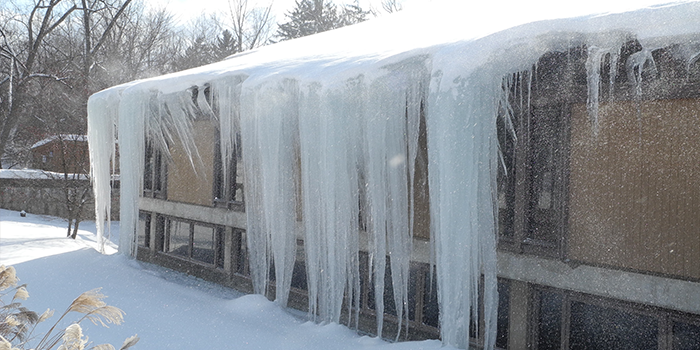
Ice Dams

Back to Education Center | Homeowners' Guide | Attic Insulation
Preventing Ice Dams
Ice dams can be a major issue for homeowners during winter months and are often caused by inadequate insulation and air-sealing in the attic space or under the roof. During winter months, you will often see some houses with significant amounts of snow on the roof, and others with little to no snow. Counter-intuitively, the snowy roofs signify better-insulated homes, as the latter group’s snow has melted and formed ice dams. Spray foam insulation can function as a comprehensive solution for the problems associated with ice dams.
How Ice Dams Form
During winter months, attic spaces can become overly warm as heat escapes from the living space and also radiates from recessed light fixtures, ductwork, furnaces, and other appliances. The heat in turn conducts through the sheathing and raises the temperature of the roof above the freezing point, which melts the snow and ice in contact with the roof surface. The snow and ice tends to melt in the areas just inside the perimeter of the exterior walls. Liquid water flows downward and refreezes as it passes over the roof overhangs, just above the soffit vents. The resulting ice builds up at the edge of the roof and in the gutters, forming a kind of dam (hence the name). As liquid water continues to form as more snow falls on the warm roof surface, it flows over the ice buildup and slowly forms icicles along the edge of the roof.
Potential Problems
Ice dams aren’t just indications of poor insulation; they can cause serious damage. Melted snow and ice can flow under shingles and soak the roof deck. The water can drip down on ceiling insulation or leak into the areas where the roof connects to the exterior walls. Wet walls and ceilings are potential areas for mold and mildew growth. Ice dams are also potentially dangerous, as the liquid water can decrease the friction between the snow and the roof surface, which can lead to mini-avalanches. Also, the icicles can potentially crack and fall on passersby.
How Spray Foam Can Help
The key to solving ice dam issues, as indicated above, is sufficiently insulating and sealing attic spaces, and the most effective method is the unvented attic. Unvented attics are enclosed, conditioned spaces incorporated into the building envelope of a home, just like the living space is. Insulation is applied to the underside of the roof decking, rather than the attic floor, and also along the rim joist. Spray foam is the only insulation material that can be applied in this manner, as batt insulation will sag and blown insulation will fall. Because the attic is sealed and insulated, its temperature is better regulated throughout the year. Essentially, the well-insulated roofline prevents the transfer of heat to the roof surface and thereby prevents the formation of ice dams.






